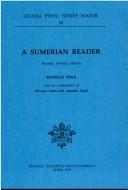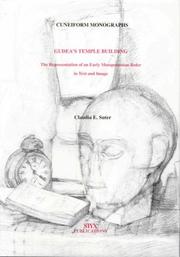Book
Year: 1968 Publisher: Leipzig : Zentralantiquariat der DDR,
Abstract | Keywords | Export | Availability | Bookmark
 Loading...
Loading...Choose an application
- Reference Manager
- EndNote
- RefWorks (Direct export to RefWorks)
Beschwörung. --- Oaths --- Sumerian language --- Sumer.
Book
ISBN: 9783447116169 3447116161 3447391359 Year: 2021 Publisher: Wiesbaden : Harrassowitz Verlag,
Abstract | Keywords | Export | Availability | Bookmark
 Loading...
Loading...Choose an application
- Reference Manager
- EndNote
- RefWorks (Direct export to RefWorks)
The Glossaire sumérien–français, principalement des textes littéraires paléobabyloniens (Sumerian – French Glossary, Primarily Based on Old Babylonian Literary Texts) endeavours to fill one of the most glaring gaps in modern Sumerology by providing a much-needed printed glossary that satisfies scientific standards. The œuvre does not strive for completeness but offers an expansive choice of words taken from Old Babylonian literary texts from the beginning of the 2nd millennium BCE. Particular attention has been paid to (idiomatic) expressions of the type ‘noun (+ noun) + verb’ such as si “horn” + gu3 “voice” + ra “to beat” = “to sound the horn.” More than one thousand of such expressions have been registered.In more than 3.800 lexicographical notes, some of which extensive, Pascal Attinger clarifies the reading of difficult lexemes, discusses the meaning of rare or unclear terms and provides a detailed bibliography which will facilitate further research. The glossary itself is preceded by a catalogue of cited compositions including abundant bibliographical references and, where applicable, information on new duplicates, a comprehensive discussion of the importance of a consistent transliteration, as well as a concordance of common readings and those adopted in the Glossary.
Linguistics --- Sumer --- Ancient Languages --- Babylon --- Assyriology --- Mesopotamia
Book
ISBN: 1646021967 9781646021963 9781646021987 1646021983 Year: 2023 Publisher: University Park : ©2023 Eisenbrauns,
Abstract | Keywords | Export | Availability | Bookmark
 Loading...
Loading...Choose an application
- Reference Manager
- EndNote
- RefWorks (Direct export to RefWorks)
Sumerian was the first language to be put into writing (ca. 3200–3100 BCE), and it is the language for which the cuneiform script was originally developed. Even after it was supplanted by Akkadian as the primary spoken language in ancient Mesopotamia, Sumerian continued to be used as a scholarly written language until the end of the first millennium BCE. This volume presents the first comprehensive English-language scholarly lexicon of Sumerian.This dictionary covers all the nuances of meaning for Sumerian terms found in historical inscriptions and literary, administrative, and lexical texts dating from about 2500 BCE to the first century BCE. The entries are organized by transcription and are accompanied by the transliteration and translation of passages in which the term occurs and, where relevant, a discussion of the word’s treatment in other publications. Main entries bring together all the parts of speech and compound forms for the Sumerian term and present each part of speech individually. All possible Akkadian equivalents and variant syllabic renderings are listed for lexical attestations of a word, and a meaningful sample of occurrences is given for literary and economic passages. Entries of homonyms with different orthographies and unrelated words with the same orthography are grouped together, each being assigned a unique identifier, and the dictionary treats the phoneme /dr/ as a separate consonant.Written by one of the foremost scholars in the field, An Annotated Sumerian Dictionary is an essential reference for Sumerologists and Assyriologists and a practical help to students of ancient cultures.
Sumerian language --- Sumérien (langue). --- Dictionaries. --- Sumer.
Book
Year: 1969 Publisher: Roma : Pontificium institutum biblicum,
Abstract | Keywords | Export | Availability | Bookmark
 Loading...
Loading...Choose an application
- Reference Manager
- EndNote
- RefWorks (Direct export to RefWorks)
Sumérien (langue) --- Agriculture --- Textes --- Administration --- Sumer --- Sources

ISBN: 8876536108 9788876536106 Year: 1997 Volume: 18 Publisher: Roma : Editrice Pontificio Istituto Biblico,
Abstract | Keywords | Export | Availability | Bookmark
 Loading...
Loading...Choose an application
- Reference Manager
- EndNote
- RefWorks (Direct export to RefWorks)
Sumerian language --- Sumer. --- Soemerisch. --- Readers. --- Readers --- Sumerian language - Readers.
Book
ISBN: 8024631342 9788024631349 9788024631301 802463130X Year: 2017 Publisher: Prague Charles University in Prague, Karolinum Press
Abstract | Keywords | Export | Availability | Bookmark
 Loading...
Loading...Choose an application
- Reference Manager
- EndNote
- RefWorks (Direct export to RefWorks)
Silence. --- Noise --- Excavations (Archaeology) --- Civilization, Assyro-Babylonian --- Sumer --- Antiquities --- Iraq
Book
Year: 1944 Volume: 2,2 Publisher: Berkeley : University of California Press,
Abstract | Keywords | Export | Availability | Bookmark
 Loading...
Loading...Choose an application
- Reference Manager
- EndNote
- RefWorks (Direct export to RefWorks)

ISBN: 9056930354 9789056930356 9789004496279 9004496270 Year: 2000 Volume: 17 Publisher: Groningen : Styx,
Abstract | Keywords | Export | Availability | Bookmark
 Loading...
Loading...Choose an application
- Reference Manager
- EndNote
- RefWorks (Direct export to RefWorks)
Gudea of Lagash, who ruled at the end of the third millennium B.C., wanted to be remembered as a temple builder. An extensive narrative inscribed on two huge clay cylinders, one of the longest and best preserved Sumerian texts, recounts his construction of the temple of Ningirsu, Lagash's patron deity. More than sixty sculpted limestone fragments belong to several stelae erected in the temples Gudea built and depict their construction. A large number of inscribed and often sculpted, artifacts provide additional information on Gudea's activities. This study treats this visual and textual material as a coherent corpus for the first time. It analyses contents, narrative structure, composition and message. Text and image are compared to elucidate the characteristics of each medium and to arrive at a comprehensive picture of the royal rhetoric of the time. The book includes a catalogue of all artifacts, and a translation of selected text passages.
Sumerian language --- Temples --- Geschiedbronnen. --- Beeldvorming. --- Tempels. --- Inschrift. --- Rhetoric. --- In literature. --- Gudea, --- Gudea (Sumer, Fürst) --- Gudea (Sumer, Fürst). --- Temples in art --- Temples in literature --- Rhetoric
Book
ISBN: 9653110047 Year: 1989 Publisher: Haifa Haifa University Press
Abstract | Keywords | Export | Availability | Bookmark
 Loading...
Loading...Choose an application
- Reference Manager
- EndNote
- RefWorks (Direct export to RefWorks)
Cuneiform inscriptions, Akkadian --- Akkadian cuneiform inscriptions --- Babylonia --- Vavilonii︠a︡ --- Bavel --- Bābil --- Babylonien --- Sumer --- History --- Sources.
Book
ISBN: 0300049455 Year: 1991 Volume: vol XVIII Publisher: New Haven London Yale University Press
Abstract | Keywords | Export | Availability | Bookmark
 Loading...
Loading...Choose an application
- Reference Manager
- EndNote
- RefWorks (Direct export to RefWorks)
Cuneiform inscriptions [Sumerian ] --- Inscriptions cunéiformes sumériennes --- Opschriften in spijkerschrift [Sumerische ] --- Cuneiform inscriptions, Sumerian --- Seals (Numismatics) --- -Sigillography --- Signets --- Sphragistics --- Diplomatics --- Glyptics --- Heraldry --- History --- Inscriptions --- Intaglios --- Numismatics --- Emblems, National --- Signatures (Writing) --- Sumerian cuneiform inscriptions --- Sumer --- -Economic conditions --- -Sources --- Cuneiform inscriptions, Sumerian. --- -Sumer --- Sigillography --- Shumer --- Sūmar --- Shūmār --- Samar --- Babylonia --- Economic conditions --- Sources --- Sumer - Economic conditions - Sources. --- Seals (Numismatics) - Sumer. --- Sumeria

 Search
Search Feedback
Feedback About UniCat
About UniCat  Help
Help News
News